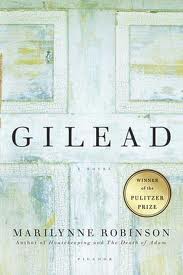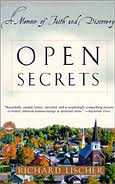 This week for my Pastoral Care course, we were asked to read the first forty or so pages of the novel Gilead, by Marilynn Robinson. It is a novel about an old preacher in a rural Iowa town. He is dying, and so he is writing memoirs to his young son.
This week for my Pastoral Care course, we were asked to read the first forty or so pages of the novel Gilead, by Marilynn Robinson. It is a novel about an old preacher in a rural Iowa town. He is dying, and so he is writing memoirs to his young son.
The questions we were asked to think about were “What is care?” and “What makes care ‘pastoral'”?
I wondered a lot about those questions in the context of this novel: it’s rural setting, it’s time period–the character is writing during the depression, or perhaps after WWI, but most certainly before WWII. For my Practicum (the course that goes along with our internship) last quarter, we were asked to read a similar book called Open Secrets by Richard Lischer. That book is about a young city-trained preacher’s encounter with the rural farming community of New Cana, Illinois.
Both books had a lot of beautiful intensity, religious strength, and some deeply powerful notions of what Christianity was, Christian community and Christian leadership.
Lischer talks about the rogate, and how valuable and important it is to a rural community. He talks about the rhythm of the religious rural life, the power in community, even gossip, in the small town. I wanted to run off and be a farmer while I was reading it; the slowness and meaningfulness of this life seemed indescribably serene and prayerful.
At one point in Robinson’s book (a novel, I might add–Lischer is memoir and Robinson is pretend memoir, so to speak), John Ames tells the story of he and his father’s trek across the country to tend his grandfather’s grave. It is perilous, lonely, and completely alien to someone of my generation. To be that lost is impossible. The closest thing I remember to it was wandering with a flat bicycle tire on the Mandan road in the Keweenaw peninsula. We were probably only about two hours walk from a store with a phone. I’m sure much less than that, in 2013, from reliable cell phone service.

Why does this matter? I guess it strikes me as odd that we’re deeply examining stories written about a rural world in our very urban school. It also strikes me as odd that we’re trying to define ‘care’ and ‘pastoral care’ with stories written about relationships and communities, and churches, quite frankly, that existed generations ago. In our projects at the Minnesota Historical Society, our directors always used to say “The Past is a Foreign Country.” The worlds described by these two preachers, steeped or not so steeped in the rural world of the 1930s and 1950s, these are alien worlds to me.
Many people in the church bemoan that the church is dying. That protestant America isn’t what it used to be; this and that. I wonder if that’s because we in seminary are being educated on this emotional and religious landscape.
It’s hard to know if basic human relationships ever really change. Are love stories basically the same across millennia, across the globe? The bond between parent and child? The relationship of the human being to worship?
So, when you ask someone “What is care?” and “What is pastoral care?”, perhaps it is based on these basic human relationships that never change. And, of course, what we call sacred history happened in a past that is even more alien to us than rural Iowa in the 1930s.
But what is the background for how we imagine ‘the preacher’ or ‘the rector’ or ‘the pastor’? How do we build this notion? Is it Richard Lischer, the awkward theologian dumped in a rural congregation that, true to form, offers him much more than he expected, while ostracizing his wife? Is it John Ames of Robinson’s novel, the elderly dying man who has spent his whole life in a rural community, who meticulously pours over sermons, goes traveling on foot with his father, and has never had any time or desire to think about money?
Maybe the idea of ‘imagining’ or creating ‘the pastor’ in the head of a young seminarian is silly to some people. If we create that idea, then we are only setting ourselves up for failure. We obviously can’t be who we read about in novels and memoirs. We are us. Of course.
But when we build a framework for who we are, what our role can or might be–we build that framework based on how we are taught to imagine it. I find a lot of problems imagining ‘pastorhood’ as who Richard Lischer was in New Cana, or who Marilynn Robinson imagines John Ames to be. It is unrealistic and perhaps even dangerous to build this as our narrative for who a pastor is–how he grows, how he learns, how he looks back on his life, how he carries out his duties, how he respects and how he disrespects.
Now, pastors (or priests) are men and women, gay and straight, single and married. Now, pastors serve congregations steeped in rural traditions, and congregations buzzing with urban fervor. Are there essential elements in this image that we’ve painted of ‘the pastor’ through these books?
Is there something inherently rural and earthy about our relations to one another in the church? They do say that the Hebrew Bible is very suspicious of cities and urban life. How does one pick out care and pastoral care in works that describe these alien worlds to us? Do we imagine them as our future, our past, or our present? How do they characterize the way we approach issues in our urban congregations in Chicago?
Does it really matter? Perhaps I wish, merely, that I had a less alien world to work with when I try to imagine my development as a care-giver, whether I go into The ministry or not. This all sounds lovely, beautiful, and powerful… but where can I find that kind of serenity here? That kind of relationship? That experience of being thoroughly lost? That loneliness? What does it look like here?

